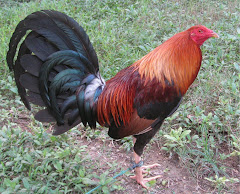Friday, January 9, 2009
Jose Rizal on cockfighting
"Touch Me Not"
by José Rizal 1887
47 The Cockpit
The Sabbath day is generally kept holy in the Philippines by going to the cockpit in the afternoon, just as in Spain it is kept by going to the bullring. Introduced and exploited for a century, cockfighting was at that time one of the vices of the people, even more widespread than opium-smoking among the Chinese. To the cockpit went the poor man to risk what little he had in order to make money without working, as well as the rich man who went to amuse himself with the money left over from his parties and the thanksgiving Masses; but at least the latter was staking his own money and his cock was trained with great care, perhaps with even greater care than his own son, his successor in the cockpit, so this was no ground for complaint.
Since the Government of that day allowed and even promoted cockfighting with the regulation that it should be held only in the public squares on holidays (to give everyone a chance to see, and to encourage by example?) from the end of High mass until nightfall, the faces in the cockpit in San Diego this Sunday were familiar.
It was no different from those in other towns except in minor details. It had three main divisions. The entrance was a large rectangle approximately twenty metres by fourteen. There was a door in one of its sides, usually in the charge of a woman who collected the entrance fees. The Government took a proportion of these fees, amounting to some hundreds of thousands of pesos a year, and it was said that the money vice thus paid for its freedom was used to build magnificent schools, bridges, and highways, and to institute awards for the development of agriculture and commerce. Blessed the vice that produced such excellent results!
In this first compartment of the cockpit might be found the peddlers of betel-nut, cigars, sweetmeats, and other eatables; here also were many young boys with their fathers or uncles, who were thus solicitously introducing them to the secrets of adult life.
This enclosure led to another slightly larger one, a kind of lobby where the public gathered before an actual cockfight. Here were to be found the majority of the fighting cocks, held to the ground by a cord fastened to a bone or wooden nail; here were the gamblers, fanciers, and gaffers. Here bets were crossed, form studied, money borrowed amid oaths, promises, and loud laughter. In one corner a sportsman handled his favourite cock, stroking its brilliant plumage; elsewhere, another counted and studied the scales on a gamecock's legs; still others recounted the feats of past victors. But there were also to be seen many crestfallen gamblers, holding a plucked carcass by its legs; the bird that had been its master's favourite for months, fondled, watched over day and night, the centre of so many dazzling hopes, was now only a carcass to be sold for a peseta and cooked with ginger and eaten that very night. Sic transit gloria mundi! So doth the glory of the world pass away!
In this lobby there was no one so stupid that he did not have a voice or so careless that he did not consider matters conscientiously, feeling the weight of the rival cocks, examining their every aspect, stretching out their wings, fingering their muscles. Some men were fashionably dressed and were followed and surrounded by those who fancied their fighting cocks. Others, dirty, their gaunt faces marked by vice, anxiously attended the movements of the wealthy and placed bets for them; pockets can be emptied of their money but not the heart of its passions. Here were no long faces; the indolent, apathetic, taciturn Filipino was not to be found here; all was movement, passionate, eager, driven by a thirst only sharpened by the muddy waters with which one thought to slake it.
This place led to the pit proper or ring, whose floor, surround by a bamboo fence, was higher than the other two compartments. In its upper part, almost reaching the roof, were stands for the spectators, for they came to the same thing, the gamblers. During the fights these stands were filled with men and boys, shouting, cheering, sweating, quarreling, swearing: fortunately there were almost never any women there. In the ring itself were the men of distinction, the wealthy the famous gamblers, the concessionaire and the referee. The birds fought on perfectly leveled ground, from which Destiny distributed laughter or tears, plenty or want.
The circle of gamblers and onlookers quickly spread the news that two famous birds would be fighting each other; each had its own history and merited fame. Everyone wanted to see and examine the two celebrities; opinions were given and prophecies made.
Voices were raised in the increasing hubbub; the ring was filling up and the stands were being taken by storm. The handlers were carrying two birds to the pit, one red the other white, already armed but with the gaffs still sheathed. Shouts were heard for the white and one or two for the red. The white was obviously the favorite.
The handlers held the birds with subtle skill so as not to be slashed by the razors. A breathless silence fell; one might have thought that all present, except for the two handlers, were dolls out of some nightmare waxworks. The gamecocks were brought together, the head of one held tight while the other pecked at it and infuriated it, and afterwards the reverse.. Every duel must be fought on equal terms, be it between Parisian cocks o' the walk or between Filipino gamecocks. Then the birds were brought face to face, nearer and nearer, so that each wretched fowl might recognize the enemy that had plucked out its feathers and which it now must fight. Their hackles rose and their small round eyes met, vibrant with hatred. The moment had come: they were placed on the ground at a certain distance from each other and left alone.
They advanced slowly, their steps audible on the hard ground; no one in the cockpit spoke or breathed. Raising and lowering their heads as if measuring each other with their eyes, the gamecocks uttered sounds, threatening or perhaps scornful. They caught sight of the razor blades, gleaming with a cold blue light; danger stimulated them, and they approached each other with determination. But a step apart, they stopped, and with fixed eyes lowered their heads and raised their hackles.
At that moment blood rushed into their tiny brains, their anger flashed like lightning and with all their natural courage they hurled themselves impetuously upon each other, beak against beak, breast to breast, steel spur against its fellow, wing to wing: but the blows were parried masterfully, and only a few feathers fell.
They sized each other up again. Suddenly the white cock leapt up, slashing with the deadly razor, but the red cock had bent its legs and lowered its head and the white cock hit only empty air. As it landed it turned quickly to protect its back and face the red cock.
The latter attacked it furiously, but it defended itself with complete self-control. It was not the favourite for nothing. Everyone followed the ups and downs of the duel with bated breath and one or another involuntary cry. Bloody feathers, both red and white, were littering the pit, but it was not a duel intended to end at the first drawing of blood; for the Filipino, following the laws of his Government, it was a duel that only death or flight could end.
Blood soaked the ground of the pit; the brave encounters were repeated again and again; but victory remained uncertain. At last, in a supreme effort, the white cock hurled itself forward to give a final blow; it nailed its spur in one of the red cock's wings. where it was caught in the bones; but the white cock had itself been hit in the breast, and the two birds, panting, exhausted, drained of their lives' blood, one joined to the other, were still, until the white cock fell, blood spurting out of its beak, its legs jerking in its last agony. The red cock, bound to it by the wing, remained standing beside it, but little by little its own legs crumpled and its eyes closed.
Dr. José P. Rizal wrote his first novel, Noli me Tangere, which was published in Europe in 1887, at the age of twenty-six. The book and its sequel, El Filibusterismo, were banned in the Philippines because of their diatribe of the country's Spanish government and clergy. Copies were smuggled in nevertheless and when Rizal returned to the Philippines after completing medical studies, he quickly ran afoul of the local government. First exiled to Mindanao, he was later arrested for "inciting rebellion" based largely on his writings. He was executed in Manila in 1896. He was only thirty-five.
Welcome. To read the articles, please click post link or month, then subsequent post link.
Ponkan broodcock

One of the ponkan broodcocks being readied by RB Sugbo for the incoming breeding season. RB Sugbo is among the gamefowl farms very much involved in the Masang Nagmamanok (MANA) Inc. nationwide gamefowl dispersal program.
Another ponkan

Another ponkan broodcock in the trio pen.
Mana: Dami at Pagkakaisa
Walang duda napakalaki na ng pinagunlad ng sabong mula sa paging libangan tuwing araw ng Linggo, ito ngayon ay isa nang napakatanyag na isport, malaking industriya at kaakitakit na mapagkakitaan.
Napakarami nang nagpapalahi ng manok panabong. Nagsilabasan ang mga babasahin at programa sa telebisyon ukol sa sabong.
Sa bawat nagpapalahi, ilan ang tagapagalaga ng kanyang manok? Sa bawat may-ari ng sabungan, ilan ang naghahanapbuhay sa sabungan niya? Sa bawat kasali sa derby, ilan ang nagbabayad sa pinto upang manood? Sa bawat malaking sabungero, ilan ang mayroon lang iilang pirasong tinale sa kanilang bakuran? Dapat lang, at napapanahon na siguro, na ang masang sabungero ay mapagtuonan ng pansin, mabigyan ng kinatawan, at, marinig ang boses sa isport at industriya ng sabong.
Ito ang nais abutin ng MANA (Masang Nagmamanok), isang pambansang kilusan at samahan ng mga masang sabungero. Ang mga layunin ng MANA ay ang sumusunod:
1. Ang pangalagaan ang kapakanan ng mga maliit na sabungero, partikular na, ang mga naghahanapbuhay sa sabungan. Inaasam na sa darating na panahon, ang mga handlers, mananari, casador, kristos, sentensiyador, farm hands ay magkakaroon ng mga benepisyo tulad ng insurance, pension at iba pa.
2. Ang mapatingkad ang kaalaman ng ordinaryong sabungero sa pagmamanok. At, sila’y mabigyan ng pagkakataon na magkaroon ng angkop na materyales sa pagpapalahi at paglalaban.
3. Ang ipaglaban ang sabong sa gitna ng banta na itoy gawing labag sa batas tulad ng nangyari kamakailan lang sa Estados Unidos, at ipreserba ito bilang isport, hanapbuhay, industriya at bahagi ng ating kultura at tunay na mana.
4. Ang magtulungan at makipagtulungan sa iba pang haligi ng industriya sa ikabubuti ng sabong at ikauunlad ng lahat na mga sabungero.
Inaasahan na matupad ng MANA ang nasabing mga layunin pamamagitan ng pagpakita ng dami at pagkakaisa.
Ang pagkatatag ng MANA ay bunsod ng mungkahi ni kamanang Boying
Ang Llamado Tayo ay tumatalakay sa ibatibang aspeto sa pagmamanok at binabasa ng napakarami arawaraw, kaya di nagtagal marami ang sumapi sa MANA.
Kasunod nito, ang MANA ay nakapagpaseminar sa ibatibang lugar at rehiyon ng Pilipinas, sa tulong ng mga kumpaniya tulad ng Excellence Poultry & Livestock Specialist, Bmeg-Derby Ace, Sagupaan, Secret Weapon, at Thunderbird.






